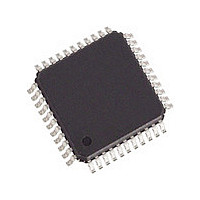DJLXT360LE.A2 Cortina Systems Inc, DJLXT360LE.A2 Datasheet - Page 29

DJLXT360LE.A2
Manufacturer Part Number
DJLXT360LE.A2
Description
Manufacturer
Cortina Systems Inc
Datasheet
1.DJLXT360LE.A2.pdf
(56 pages)
Specifications of DJLXT360LE.A2
Number Of Transceivers
1
Operating Supply Voltage (typ)
5V
Screening Level
Industrial
Mounting
Surface Mount
Operating Supply Voltage (min)
4.75V
Operating Supply Voltage (max)
5.25V
Operating Temperature (min)
-40C
Operating Temperature (max)
85C
Lead Free Status / RoHS Status
Supplier Unconfirmed
Available stocks
Company
Part Number
Manufacturer
Quantity
Price
LXT360 Transceiver
Datasheet: Long Form
249231, Revision 2.1
24 January 2008
2.7.4.2
2.7.4.3
2.7.4.4
2.7.5
2.7.5.1
2.7.5.2
Cortina Systems
Alarm Indication Signal Detection (AIS)
This function is only available in Host mode. The receiver detects an AIS pattern when it
receives fewer than three 0s in any string of 2048 bits. The device clears the AIS condition
when it receives three or more 0s in a string of 2048 bits.
The AIS bit in the Performance Status Register indicates AIS detection. Whenever the AIS
status changes, bit TSR.TAIS =1. Unless masked, a change of AIS status generates an
interrupt.
Driver Failure Monitor Open (DFMO)
This function is only available in Host mode. The DFMO bit is available in the Performance
Status Register to indicate an open condition on the lines. DFMO can generate an interrupt
to the host controller. The Transition Status Register bit TDFMO indicates a transition in the
status of the bit. Writing a 1 to ICR.CDFMO will clear or mask the interrupt.
Elastic Store Overflow/Underflow (ESOVR and ESUNF)
This function is only available in Host mode. When the bit count in the Elastic Store (ES) is
within two bits of overflowing or underflowing the ES adjusts the output clock by
period. The ES provides an indication of overflow and underflow via bits TRS.ESOVR and
TSR.ESUNF. These are “sticky bits” and will stay set to 1 until the host controller reads the
register. These interrupts can be cleared or masked by writing a 1 to the bits ICR.CESO and
ICR.CESU, respectively.
Other Diagnostic Reports
Receive Line Attenuation Indication
This function is only available in Host mode. The Equalizer Status Register (ESR) provides
an approximation of the line attenuation encountered by the device. The four MSBs of the
register (ESR.LATN7:4) indicate line attenuation in approximately 2.9 dB steps for both T1
and E1 operation of the receive equalizer. For instance, if ESR.LATN7:4 is 10 (decimal), then
the receiver is seeing a signal attenuated by approximately 29 dB (2.9 dB x 10) of cable
loss.
Built-In Self Test (BIST)
The BIST function in only available in Host mode. The BIST exercises the internal circuits by
providing an internal QRSS pattern, running it through the encoders and the transmit drivers
then looping it back through the receive equalizer, jitter attenuator and decoders to the
QRSS pattern detection circuitry. The BIST is initiated by setting bit CR3.SBIST = 1. If all the
blocks in this data path operate correctly, the receive pattern detector locks onto the pattern. It
then pulls INT Low and sets the following bits:
The QPD pin also indicates completion status of the test. Initiating the BIST forces QPD
High. During the test, it remains High until the test finishes successfully, at which time it goes
Low. Note that during BIST, the TPOS/TNEG inputs must remain at logic level = 0. The most
reliable test will result when a separate TCLK and MCLK are applied and the Line Build-Out
(LBO) is set to -22.5 dB (CR1.EC4:1 = 011x).
®
• TSR.TQRSS = 1
• PSR.QRSS = 1
• PSR.BIST = 1
LXT360 Integrated T1/E1 LH/SH Transceiver for DS1/DSX-1 or PRI Applications
TM
TM
2.7 Diagnostic Mode Operation
1
/
8
of a bit
Page 29













